- In-house BIM allows for customized control and improved team synergy but demands high investment in staff and training.
- Outsourced BIM offers specialized skills, closes expertise gaps and offers growth potential.
- When considering BIM outsourcing, it’s crucial for firms to scrutinize partners’ communication methods, management of revisions, pricing, and quality controls.
In the Architectural, Engineering, and Construction (AEC) sector, leveraging Building Information Modeling (BIM) services is vital for operational efficiency and cost management. However, a fundamental issue that needs to be faced is whether to handle BIM services in-house or outsource them.
Table of Contents
- Challenges of Running In-house BIM Services
- The Advantages of an In-house BIM Services Model
- The Advantages of an Outsourced BIM Services Model
- A Quick Checklist for Using an In-house Team
- A Quick Checklist if You are Considering Outsourcing
- BIM Outsourcing Success Stories
- Comparative Analysis of Outsourced vs In-house BIM
In-house BIM management allows for direct control, better communication, and tailored solutions to a firm’s specific needs. But it may suffer from limited resources, expertise, and could lead to higher costs and project delays.
On the other hand, outsourcing BIM services to specialized firms brings in technical expertise, cost-effectiveness, and timely project delivery at the expense of lesser control and potential communication hurdles. As this decision significantly impacts a firm’s ability to meet project objectives and growth it is necessary to have a look at the pros and cons of both workflow avenues.
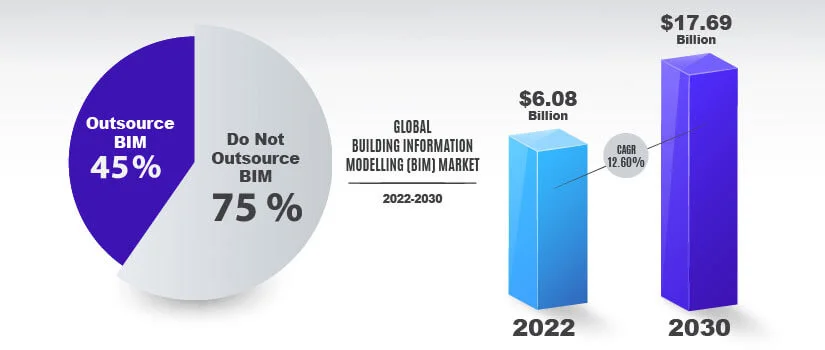
Let us discuss the advantages and challenges for both models: in-house as well as an outsourced model.
Challenges of Running In-house BIM services
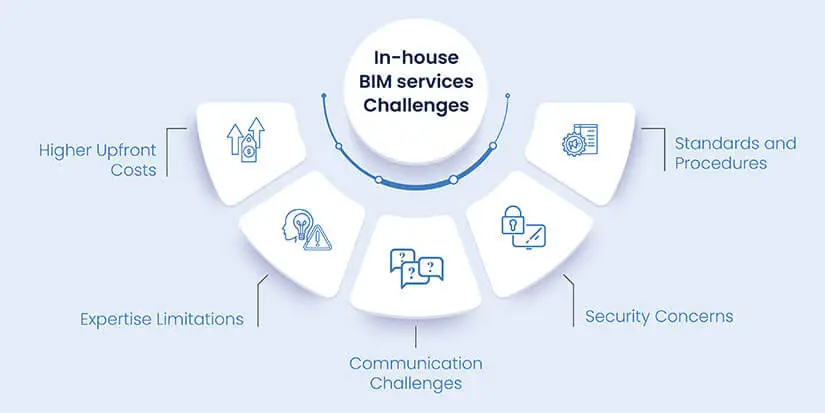
Higher upfront costs for software, hardware, and training
Running in-house BIM services can be challenging due to the high upfront costs of BIM tools, training, and hardware. The acquisition of compatible hardware and advanced BIM tools necessitates a substantial investment, while training programs require team members to possess a higher level of proficiency, adding to the financial burden.
The costs of adopting BIM processes and tools can strain SMB budgets. Additionally, software updates and ongoing training require financial commitments. To remain competitive, AEC organizations must balance strategic planning and resource allocation.
Potential limitations in terms of expertise and capabilities
Running in-house BIM services poses challenges due to limitations in capabilities and expertise. BIM necessitates diverse skills in architectural design and software proficiency. In-house teams lack the specialized expertise found in BIM outsourcing companies, which hinders their ability to handle complex projects.
Continuous training is needed to keep up with new BIM technologies and standards, but it can strain resources. This can lead to project execution gaps that hinder innovation and competitiveness. To overcome these obstacles, it is important to invest in skill development and expand in-house expertise to meet the demands of the construction industry.
Based on Cresire’s BIM survey, lack of BIM expertise was one of the reasons for 30% of the respondents to outsource BIM services. Source: Creire Consulting
Communication and coordination challenges
Running in-house BIM services poses challenges in coordination and communication, as effective communication is crucial for teams to collaborate and be on the same page. In-house teams struggle with clear communication, resulting in delays and potential errors.
Coordinating tasks within a construction firm requires accurate planning and real-time data sharing. Differences in opinions and perspectives among team members further complicate matters. Overcoming these challenges necessitates strict communication protocols, advanced collaboration tools, and shared project objectives. Addressing collaboration gaps ensures effective teamwork, enhances project outcomes and achieves client satisfaction.
Security concerns regarding proprietary information
Security concerns regarding proprietary information involve sensitive project data, such as architectural plans, engineering details and proprietary workflows. In-house systems must ensure complete data security to prevent unauthorized access, data breaches, or theft of intellectual property. The fear of information falling into the wrong hands can be a critical bottleneck. Regular audits, updates, cybersecurity measures, encryption protocols and strict access controls need to be implemented for continuous vigilance and investment security. Bottom of Form
Possible differences in standards and procedures
Managing in-house BIM services involves security concerns due to procedural and standard disparities. These disparities can hinder collaboration, leading to misunderstandings and inefficiencies in project workflows.
Continuous vigilance and training are necessary to maintain a collaborative work environment and to align diverse standards. Inconsistencies in procedures hinder project progress, resulting in errors and delays. Overcoming these challenges requires proactive communication, training, and a commitment to standardizing internal protocols. By standardizing their approach, in-house teams can enhance collaboration and ensure efficient BIM processes for project success.
Your BIM projects demand precision, quick turnaround and high efficiency.
Outsource your projects to the industry leaders.
The Advantages of an In-house BIM Services Model
Full control over the BIM process and data
The benefits of an in-house BIM services model are numerous. We have complete control over BIM processes and project data, allowing us to align our project needs with our organizational goals. This enables companies to have a cohesive workflow through collaboration and efficiency, ensuring swift integration with other trades and teams.
Furthermore, in-house BIM services offer faster response times and improved adaptability to meet client needs and handle project modifications. Internal control allows companies to quickly customize BIM strategies according to requirements and standards. This independence ensures precision, security, and a tailored approach, making in-house BIM services the preferred choice for many AEC companies.
Seamless integration with other internal departments and teams
Cohesion allows AEC firms to collaborate effectively by harmonizing BIM data with multiple project facets. Through real-time engagement, they can coordinate project teams efficiently to ensure seamless alignment of trades, such as architecture, structure, and MEP elements, during design and construction.
This kind of integration improves workflows, decision making, and project productivity. The in-house BIM services model fosters collaboration between teams to deliver projects on budget and schedule. And the harmonization enhances project quality and strengthens organizational solidarity.
Immediate availability and quicker response times
With an in-house team, firms benefit from immediate availability and faster response times due to the absence of any delay in accessing BIM expertise and tools. Professionals within the organization are readily available, enabling swift responses to meet project requirements and address client feedback. This speed is crucial, as it facilitates quick decision-making to ensure project progress.
Faster response times result in improved agility, allowing for swift adjustments to design, schedules, and client needs. This advantage enhances client satisfaction and boosts project productivity. In-house teams foster a proactive approach to efficiently address business demands and overcome challenges. This ensures accelerated project execution and high levels of client satisfaction.
Don’t let the hassles of hiring, training and software upskilling impede construction efficiencies.
Unlock BIM excellence across projects.
The Advantages of an Outsourced BIM Services Model
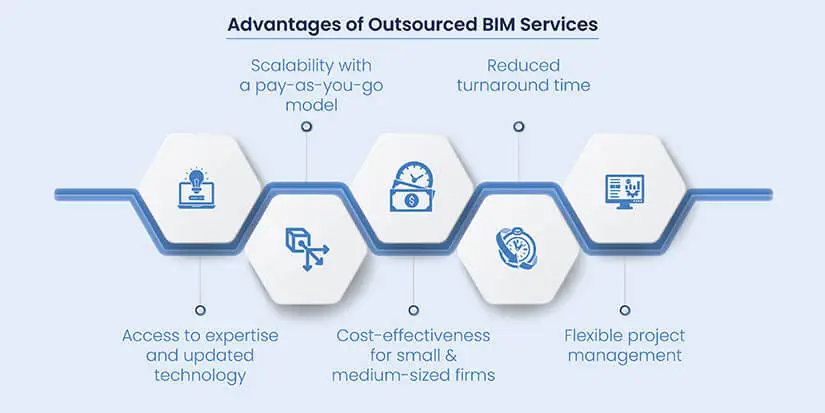
Access to specialized expertise and updated technology
Outsourcing BIM services offers numerous advantages in design and construction. One key benefit is access to updated technology and specialized expertise. Outsourced BIM firms employ professionals with core field expertise to ensure high accuracy and efficiency in project execution.
These experts possess knowledge of the latest BIM technology and tools, ensuring effective project execution with the latest BIM processes. Additionally, outsourcing BIM services allows companies to focus on core competencies while specialists handle BIM modeling tasks. This approach improves productivity and leads to cost savings.
Scalability: Pay for services only when you need them
Outsourced BIM services offer a significant advantage in scalability, allowing businesses to pay for services as needed. This flexibility is invaluable in the dynamic construction industry, as it enables companies to meet fluctuating project demands. By outsourcing BIM requirements, companies can adjust their BIM support to specific project needs, eliminating the need for a fixed in-house team. Paying for services on a project basis allows businesses to allocate resources effectively and to ensure the utilization of precise expertise. Scalability not only improves costs, but also enhances overall project effectiveness, increasing agility and competitiveness.
Cost-effective in the long run, especially for smaller companies
Being cost-effective in the long run is crucial for small-and medium-sized AEC firms. These firms often face limited resources and can incur significant financial burdens, such as hiring and training costs, when taking an in-house approach. Additionally, they may need to invest in expensive software. However, outsourcing BIM services can alleviate these financial strains and provide access to industry expertise without the need for initial expenses.
Furthermore, outsourcing BIM services eliminates operational costs, such as benefits and salaries. This allows firms to pay only for the project deliverables they require, avoiding unnecessary expenses. By adopting this financial approach, AEC firms can confidently compete in the industry, maximize their budgets, and maintain high-quality BIM solutions.
Experience the cohesive power of operational flexibility, scalability, efficiency and seamless collaboration.
Start your BIM outsourcing journey today.
A Quick Checklist for Using an In-house Team
Who will source, interview, and hire your team?
When opting for an in-house team, it is important to answer crucial questions, such as who will handle the sourcing process, conduct interviews, and make the final hiring decision. Accurate planning and expertise are essential to ensure the selection of the right candidates for BIM project execution.
Which candidates are good?
Evaluating the right candidates to form an in-house BIM team requires precision. Which candidate possesses the requisite skills, cultural fit and expertise? Identifying candidates is crucial to forming a high-performance and cohesive in-house workforce.
What if there’s no one in your area?
Local availability for an in-house BIM team is crucial. What if there is an unavailability of candidates in your vicinity? Remote hires or other partnerships may be required to hire appropriate talent for your team.
Which software should you use?
Selecting the appropriate BIM tools or software for an in-house workforce necessitates careful consideration and precision. Key factors to consider include the software’s alignment with project requirements, the team’s skills, and financial constraints. Considering these factors enhances productivity and facilitates efficient collaboration, which is crucial for successful BIM implementation within the AEC firm.
Who will bring the team together?
A strong and capable leader is essential for an in-house BIM team. This individual will possess the ability to bring together a diverse range of skills, foster collaboration and ensure a smooth workflow. It is crucial to identify a team leader who can effectively communicate and lead the group toward a shared vision, resulting in successful outcomes.
What will the CAPEX and OPEX be?
Calculating OPEX and CAPEX is crucial for an in-house BIM workforce. What are the initial in-house investments, operational costs, and returns? Meticulous budget planning leads to higher sustainability, cost-positive BIM deployments and alignment with the firm’s goals and budget.
How much time and growth opportunities are you losing?
Evaluating the in-house team is required to assess cost opportunities. Assessing parameters such as time, growth, and innovation hold substantial importance. Identifying these elements quantifies effective BIM deployment with strategic decision making and schedule significance.
How safe is your knowledge investment?
Securing knowledge investment is essential for an in-house BIM workforce. How safe are intellectual property, project insight, and expertise? Answering this question requires stringent data security, preservation of knowledge base, and safeguards against vulnerabilities and threats.
A Quick Checklist if You are Considering Outsourcing
Who are they?
While outsourcing BIM services, it is important to clarify the BIM service provider’s identity, reputation and expertise for reliability and efficient collaboration.
What’s the outsourcing company’s track record in delivering BIM services?
Assess the outsourced BIM service provider by evaluating its past performance based on reliability, quality, and client satisfaction to ensure successful project collaboration in providing high-end BIM services.
Do they have client testimonials or case studies to showcase their expertise?
Verify the outsourced provider’s team expertise through client reviews, testimonials, and case studies to ensure competence and credibility within their service offerings.
What industries or sectors have they mainly served?
Determine the outsourced teams’ expertise through served industry or sector assessments for relevant project experience and expertise.
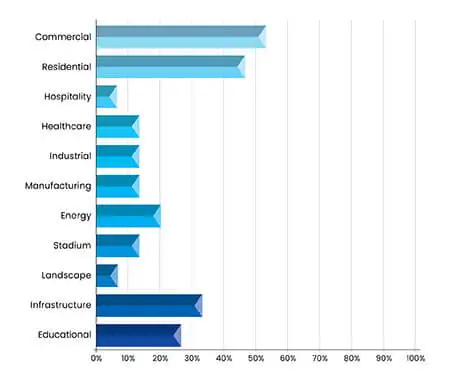
What BIM standards and software are they proficient in?
Check the BIM outsourcing team’s proficiency in software and standards delivery to learn whether their expertise conforms to actual project needs and client expectations.
Do they have specialists for specific areas of BIM (like MEP, structural, or architectural)?
Assess the team’s skills and expertise through careful consideration of specialized professionals for various trades including architecture, structure, and MEP.
What kind of training and certifications do their team members hold?
Training and certification are crucial for team members. Explore their training and certifications for competency assurance.
What measures do they have in place to ensure the safety and security of your data?
Ensure the outsourced teams’ reliability by assessing measures and data security protocols to secure confidential information about the project.
Is there a confidentiality or non-disclosure agreement in place?
Make sure information security is established with the outsourced BIM service provider by establishing and implementing a non-disclosure or confidentiality agreement.
How do they store, backup, and manage the data they handle?
Appraise data safeguards by inquiring about the outsourcing partner’s data storage, management procedures, and data storage to validate reliability and confidentiality.
What tools or platforms do they use for communication and project management?
Clarify communication strategies or tools by inquiring about the outsourced companies’ platforms or tools to achieve seamless collaboration and efficient project management.
How do they charge for additional work or changes mid-project?
Define the cost structure by understanding the team’s pricing policies for more work or project changes midway to manage the budget effectively.
What’s the expected turnaround time for minor vs. major revisions?
Check for adaptability regarding flexibility for revisions and clarity within charging policies for mid-project changes and excess work.
Is it a flat fee, hourly rate, or based on project milestones?
Assess the payment model to achieve transparency in learning about the firm’s flat fee or hourly rate, or base fees based on project milestones.
Are there any hidden costs or potential additional charges you should be aware of?
Inquire about the team’s structure and evaluate potential supplementary charges and hidden costs for better clarity.
How does payment work – upfront, in stages, or after completion?
Define pricing to learn about the firm’s payment structure as upfront, staged, or upon project completion to achieve efficient and strategic project planning.
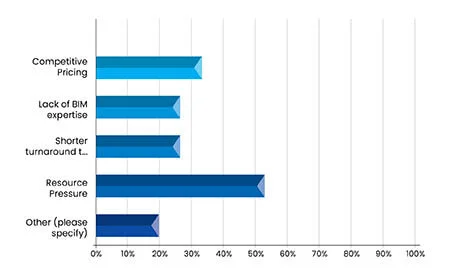
What quality assurance processes do they have in place?
Validate quality measures through quality assurance processes in place to ensure accurate, reliable, and high-quality standards.
How do they handle discrepancies or errors in their work?
Check for quality control processes in place to handle ambiguities or errors and achieve high-quality project deliverables and successful outcomes.
Is there a review or validation process before final deliverables are handed over?
Verify standards for quality by confirming the teams review or validation process before handing over the final project deliverables for precision and excellence.
Will they provide post-project support or training if needed?
Scrutinize post-project support or training after completion to achieve a swift transition and to drive perpetual assistance.
How do they manage project handover and the transition of data/files?
Confirm procedures for post-project data, information handover, or transition to ensure effectiveness and efficiency in the BIM project.
Do they offer any long-term partnerships or maintenance services?
Check for the BIM outsourcing team to determine whether it offers maintenance services or partnerships for continuous project development and support.
Can they connect you with past or current clients for feedback?
Corroborate the credibility of the BIM outsourcing team by checking if it can provide references and connect firms with past or current clients to get valuable feedback.
Have they worked on projects similar to yours in size, scope, or industry?
Request and confirm references to check credentials of the BIM outsourcing team and their experience in similar projects, including scope, size, and industry.
BIM Outsourcing Success stories
99% FTR clash-free 3D models save time and costs for a US-based engineering consultant.
A US-based client specializing in engineering and consulting partnered with Hitech for their commercial projects. They outsourced their needs to the team at HitechDigital to create spatially coordinated and clash-free 3D models for MEP systems and to generate an accurate and complete set of construction documents for MEP component placement and service design.
Navigating across challenges that included working with teams across multiple geographies and time zones and conforming to short and stringent deadlines, the team at HitechDigital achieved the required deliverables.
With clash detection reports, client reviews, and quality checks in place, the team was able to achieve:
- Hassle-free and quick installation of MEP components
- 99% FTR accuracy that resulted time and cost savings
- Complete client satisfaction of 4/5 for the entire project
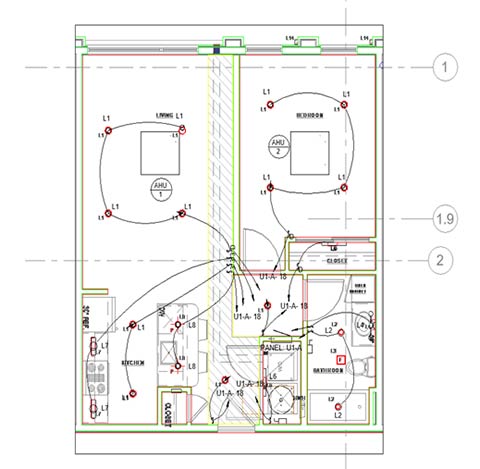 Electric Lighting Plan
Electric Lighting Plan
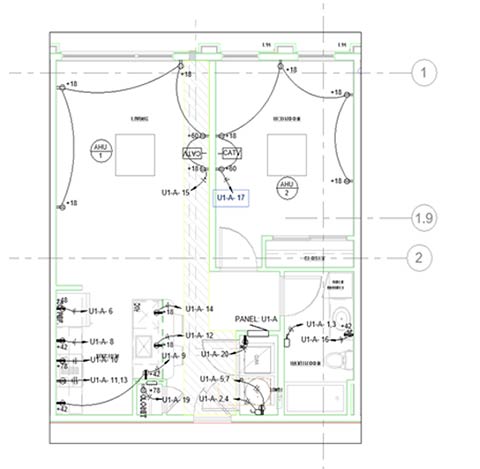 Electric Power Plan
Electric Power Plan
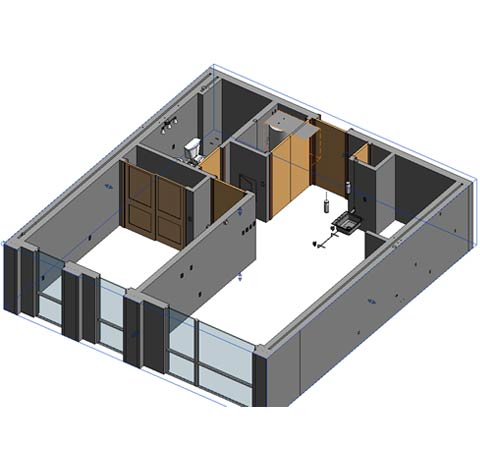 3D Model – Electric Power
3D Model – Electric Power
Clash-free MEP model ensures 100% installation of MEP components at airport in Oman.
A leading construction and engineering company from the Middle East outsourced its needs for an airport construction project to HitechDigital. Architectural, Structural, and MEP work was planned for various areas of the terminal including North and South Tier, passenger terminals, and office buildings.
The client partnered with Hitech for MEPF work to:
- Create a 3D MEPF BIM model at LOD 400
- Generate clash detection reports
- Produce accurate and detailed Quantity Takeoffs
- Ensure the MEPF model and layout connects with architectural and structural design
With a team of more than 20 MEP engineers and the use of Revit and Navisworks, the team identified 2D input drawings, built MEP models to resolve clashes, generated coordinated drawings and QTO’s, resolved constructability issues, and deployed multilayered checks.
The deliverables supported the client with:
- Exceptional cost and time savings for MEPF installation over a period of six months
- Timely completion of the terminal installation of 100% MEPF systems
- Reduction in the numbers of change orders to save MEP costs
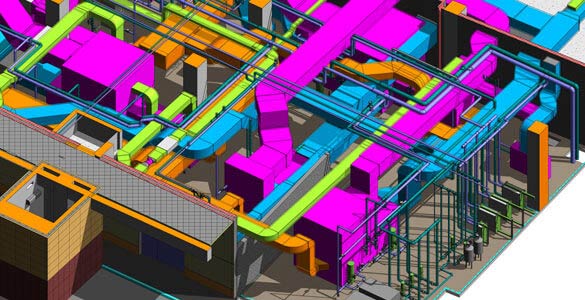 Airport Plantroom MEP System
Airport Plantroom MEP System
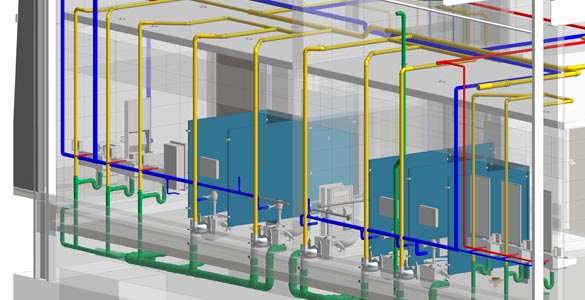 Drainage and Water Supply System
Drainage and Water Supply System
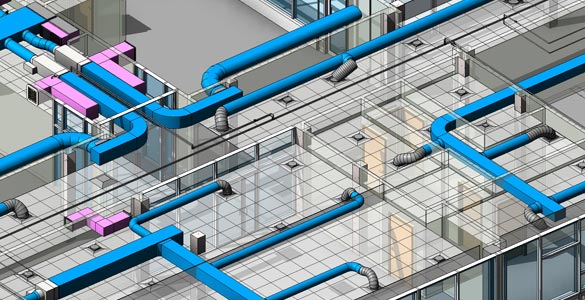 Office Building MEP System
Office Building MEP System
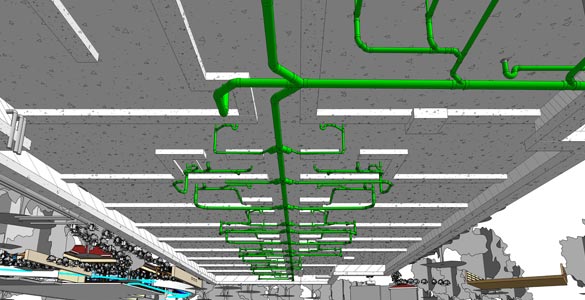 Under Ground Drainage System
Under Ground Drainage System
Comparative Analysis of Outsourced vs In-house BIM
| Aspect | In-House BIM services | Outsourced BIM services |
|---|---|---|
| Communication | In-House BIM services Immediate communication to foster seamless collaboration and understanding internal workflows. | Outsourced BIM services Potential challenges within communication based on language differences and time zone differences. |
| Cost Efficiency | In-House BIM services Incurs higher costs due to benefits, salaries, and training of in-house workforce. | Outsourced BIM services More cost-effective based on lower overhead costs and reduced labor. |
| Flexibility and Scalability | In-House BIM services Limitations in scalability based on varying workloads and existing staff. | Outsourced BIM services Offers exceptional flexibility to scale up or scale down resources based on project needs. |
| Data Security and Control | In-House BIM services Better control over data security and internal processes to ensure compliance and confidentiality. | Outsourced BIM services Needs vetting of outsourcing partners to address data security concerns. |
| Specialized Expertise | In-House BIM services Complete knowledge of specific needs and company culture with expertise customized for internal requirements. | Outsourced BIM services Better access to specialized expertise and skills as outsourced teams offer innovative solutions. |
Conclusion
In conclusion, when making decisions to either opt for an in-house BIM team or outsource BIM services, strategic choices require careful consideration. As both approaches showcase distinct opportunities and challenges for unique organizations, it is important for stakeholders to assess every parameter and receive answers to questions with clarity. Outsourcing delivers greater scalability, flexibility, and cost efficiency for specialized expertise.
In contrast, in-house BIM potential showcases better control and responsiveness but requires initial investment. Evaluating factors like project complexity, budget restraints and expertise is imperative. A prudent evaluation of these parameters ensures the utilization of suitable and effective BIM services customized for unique project needs.
Elevate your designs, reduce errors, and stay on schedule. Every time.
Request our BIM outsourcing services today.






